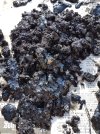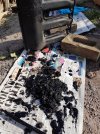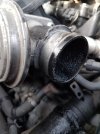MollyNomad
Well-Known Member
- Posts
- 505
- Location
- Scotland
Hello Folks.
Following my post regards IRD bearing replacement I have finally go the unit out
1. Without killing myself
2. Without damaging IRD.
Have a replacement bearing kit with Timken items which I was quite pleased to get.
Anyhoo last night whilst under the car looking up into the hole where the IRD resides I was met with a worrying site. My turbo is covered in oil.. obviously the ‘black stuff’. It’s ‘honking’ and I’m pretty sure it wasn’t that bad a week or so ago.
So looking for advice as to what to do. My main concern is a ‘runaway’ which, whilst being spectacular isn’t really ‘my cup of tea!’
I’m assuming that the turbo seals have failed hence the oil. The car ran okay when I last drove it (a couple of weeks back) no smoke etc. only noticed a sound, (other than grumbling bearing from IRD) a funny ‘rattle’ usually on mild acceleration which disappears when not under load.. If I am honest it sounds like a Speedo ‘drive’ that you used to get on older cars.. obviously not that here..
Anyhoo any advice would be good. Would rather have ago at sorting this issue if it can be sorted with the IRD Out/off other than a revisit/IRD removal again. Not wanting to risk driving/running the car until this is fixed. Noted that when I removed the induction pipe work at the front of the engine that some oil dropped onto the floor a short wil later leaving a puddle the size of 6-8 50p pieces in the floor.
TIA…
Following my post regards IRD bearing replacement I have finally go the unit out
1. Without killing myself
2. Without damaging IRD.
Have a replacement bearing kit with Timken items which I was quite pleased to get.
Anyhoo last night whilst under the car looking up into the hole where the IRD resides I was met with a worrying site. My turbo is covered in oil.. obviously the ‘black stuff’. It’s ‘honking’ and I’m pretty sure it wasn’t that bad a week or so ago.
So looking for advice as to what to do. My main concern is a ‘runaway’ which, whilst being spectacular isn’t really ‘my cup of tea!’
I’m assuming that the turbo seals have failed hence the oil. The car ran okay when I last drove it (a couple of weeks back) no smoke etc. only noticed a sound, (other than grumbling bearing from IRD) a funny ‘rattle’ usually on mild acceleration which disappears when not under load.. If I am honest it sounds like a Speedo ‘drive’ that you used to get on older cars.. obviously not that here..
Anyhoo any advice would be good. Would rather have ago at sorting this issue if it can be sorted with the IRD Out/off other than a revisit/IRD removal again. Not wanting to risk driving/running the car until this is fixed. Noted that when I removed the induction pipe work at the front of the engine that some oil dropped onto the floor a short wil later leaving a puddle the size of 6-8 50p pieces in the floor.
TIA…
Last edited:



